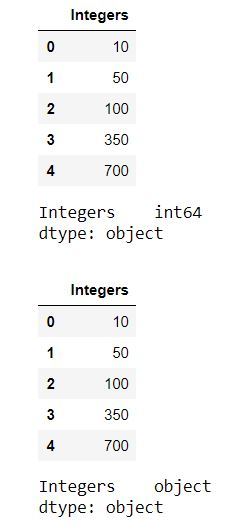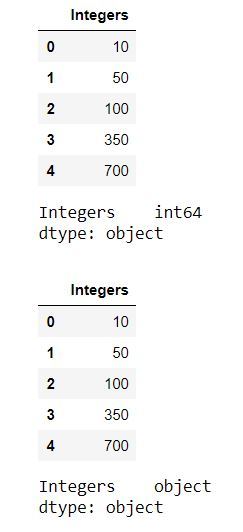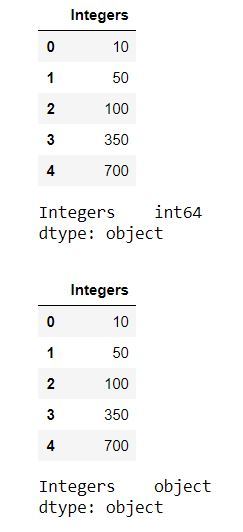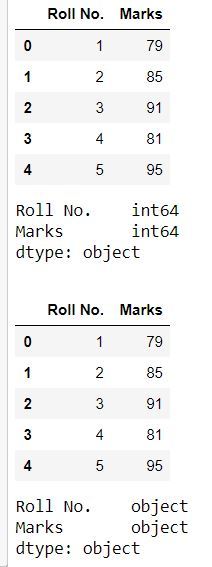如何在Pandas数据框架中把整数转换成字符串
在这篇文章中,我们将看看在Pandas数据框架中把一个整数转换成字符串的不同方法。在Pandas中,我们可以使用不同的函数来实现这一任务。
- map(str)
- astype(str)
- apply(str)
- applymap(str)
例子1 :在这个例子中,我们将使用map(str)函数把一列整数的每个值转换成字符串。
# importing pandas as pd
import pandas as pd
# creating a dictionary of integers
dict = {'Integers' : [10, 50, 100, 350, 700]}
# creating dataframe from dictionary
df = pd.DataFrame.from_dict(dict)
print(df)
print(df.dtypes)
print('\n')
# converting each value of column to a string
df['Integers'] = df['Integers'].map(str)
print(df)
print(df.dtypes)
输出 :

在上面的输出中我们可以看到,在数据类型是int64之前,在转换为字符串之后,数据类型是一个代表字符串的对象。例2:在这个例子中,我们将使用astype(str)函数将一列整数的每个值转换为字符串。
# importing pandas as pd
import pandas as pd
# creating a dictionary of integers
dict = {'Integers' : [10, 50, 100, 350, 700]}
# creating dataframe from dictionary
df = pd.DataFrame.from_dict(dict)
print(df)
print(df.dtypes)
print('\n')
# converting each value of column to a string
df['Integers'] = df['Integers'].astype(str)
print(df)
print(df.dtypes)
输出 :

在上面的输出中我们可以看到,在数据类型是int64之前,在转换为字符串之后,数据类型是一个代表字符串的对象。例3:在这个例子中,我们将使用apply(str)函数将一列整数的每个值转换为字符串。
# importing pandas as pd
import pandas as pd
# creating a dictionary of integers
dict = {'Integers' : [10, 50, 100, 350, 700]}
# creating dataframe from dictionary
df = pd.DataFrame.from_dict(dict)
print(df)
print(df.dtypes)
print('\n')
# converting each value of column to a string
df['Integers'] = df['Integers'].apply(str)
print(df)
print(df.dtypes)
输出 :

在上面的输出中,我们可以看到,之前的数据类型是int64,转换为字符串后,数据类型是一个代表字符串的对象。例子4:我们在上面看到的所有方法都是将单个列从整数转换为字符串。但是我们也可以使用applymap(str)方法将整个数据框架转换为字符串。
# importing pandas as pd
import pandas as pd
# creating a dictionary of integers
dict = {'Roll No.' : [1, 2, 3, 4, 5], 'Marks':[79, 85, 91, 81, 95]}
# creating dataframe from dictionary
df = pd.DataFrame.from_dict(dict)
print(df)
print(df.dtypes)
print('\n')
# converting each value of column to a string
df = df.applymap(str)
print(df)
print(df.dtypes)
输出 :

我们可以在上面的输出中看到,在数据类型是int64之前,在转换为字符串之后,数据类型是一个代表字符串的对象。
 极客教程
极客教程